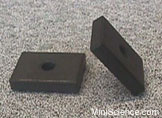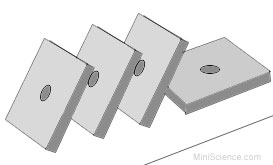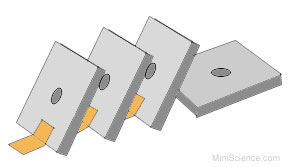
Equilibrium
The downward force of gravity
may balance with an upward repelling force of a magnet to form an
equilibrium. A magnetic equilibrium may also involve more than one magnet.
Finding the equilibrium is a challenging
task. It becomes more challenging if the equilibrium is involving more than
one element. Elements in an equilibrium are sensitive to small forces that
may change the balance of the equilibrium.
|
Try this:
In this experiment you use the rectangular
magnets that you received with your kit. You need a rough surface so the
magnets can not slide on that. You may use a sand paper as the ground for
these experiments.
|

|
Identify the poles: Move one face of
the magnet towards the compass (from the side). The compass will show if
that face is North or South. Mark both faces in all your rectangular
magnets.
Find the equilibrium: Place one
magnet horizontally and then move another magnet towards that from the top
such that like poles are facing each other and two magnets repel. When you
feel the repelling force, gradually and slowly move the upper magnet to one
side and let it stand in one edge. Adjust the distance to find the
equilibrium. If your flat magnet starts to move, temporarily hold it with
your finger or put some sticky material under that so it will not move.
| Additional magnets can be
added to this equilibrium from the side. Again like poles must face
each other.
Find out how many slanted magnets you
can stand in row in an equilibrium state. |
 |
| If you don't have a rough
surface for this experiment, you may need to use tape to hold the
bottom of the magnets in place. |
 |
| The equilibrium may be achieved
with different arrangements of different magnets. |
 |
| The above instructions are
based on the materials included in the magnet levitation science set
of MiniScience.com. If you don't have these materials yet, you may use
the following link to order them.
Magnet Levitation Part#KITML |
|
|






